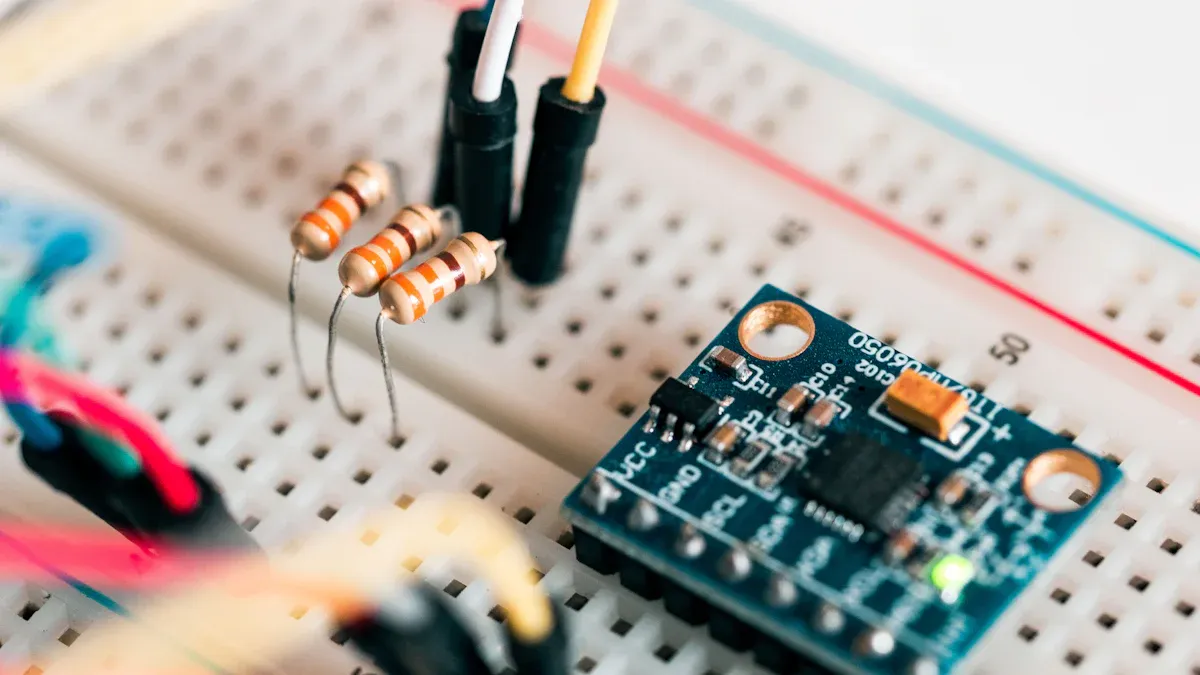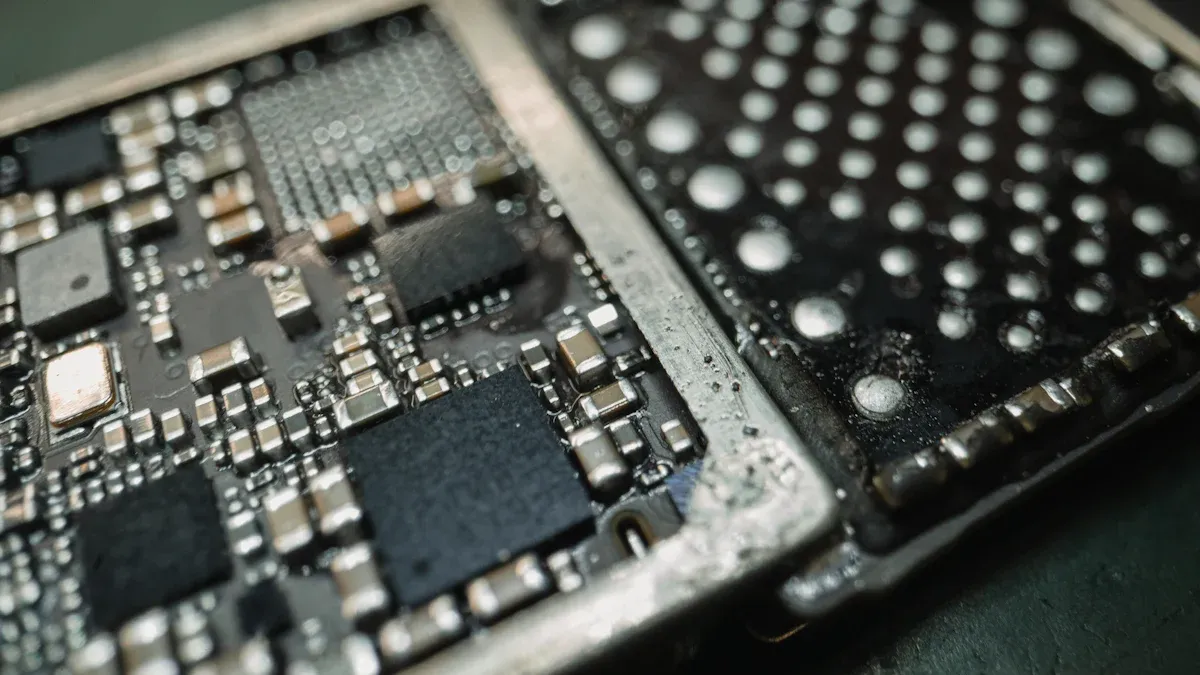What is a Volume Control 44QFP Chip and How is it Used

A VOLUME CONTROL 44QFP chip manages sound levels in electronic devices. This chip uses electronic signals to adjust audio volume instead of manual knobs. Engineers use it to create precise and reliable audio control in products like speakers and televisions. Its compact design allows easy integration into modern electronics. Users benefit from smoother and more consistent sound adjustments.
Key Takeaways
The Volume Control 44QFP chip adjusts sound levels electronically, replacing old manual knobs for smoother and more precise volume control.
Its small 44QFP package saves space and fits easily into modern devices like speakers, TVs, and car audio systems.
The chip works quietly and reliably, with no moving parts, making it last longer and reduce noise during volume changes.
It connects easily with digital systems, allowing remote and automated volume control through buttons, apps, or remotes.
Users enjoy consistent sound quality and the chip remembers the last volume setting, improving the overall listening experience.
Features
44QFP Package
The 44QFP package gives the VOLUME CONTROL 44QFP chip a compact and efficient design. This package uses a surface-mount style, which allows manufacturers to place the chip directly onto printed circuit boards using automated machines. The small size, measuring only 10 mm by 10 mm with a height of 2.1 mm, makes it ideal for devices where space is limited. Many consumer and industrial products use this package because it supports multi-channel analog output and works well in different environments. The chip operates reliably in temperatures from -40°C to 85°C and can handle up to 0.5 watts of power.
Tip: The 44QFP package helps engineers save space and improve assembly speed in modern electronics.
Parameter | Specification |
|---|---|
Package Dimensions | 10 mm x 10 mm |
Package Height | 2.1 mm |
Operating Temperature | -40°C to 85°C |
Supply Voltage | 4.5 V to 5.5 V |
Maximum Power Dissipation | 500 mW (0.5 W) |
Mounting Style | Surface Mount (SMD/SMT) |
Electronic Volume Control
The VOLUME CONTROL 44QFP chip uses electronic volume control to manage sound levels. This method replaces old-fashioned mechanical potentiometers, which rely on manual turning or sliding. Electronic control uses digital signals from a microcontroller or digital circuit. This approach allows for precise, step-by-step adjustments. The chip can receive commands from a remote or an automated system, making it easy to change the volume without touching the device.
Electronic volume control offers:
High precision with digital steps
No moving parts, so it lasts longer
Quiet operation with less noise
Easy integration with digital systems
Feature | Mechanical Potentiometer | Electronic Potentiometer (Digipot) |
|---|---|---|
Control Mechanism | Manual rotation or sliding | Digital signals from a controller |
Precision | Limited by mechanical parts | High, with digital increments |
Lifespan | Wears out over time | Long, no moving parts |
Adjustment | Manual, less repeatable | Precise, repeatable, remote possible |
Integration | Analog circuits only | Works with digital circuits |
Susceptibility to Wear | High | None |
Remote Control | Not possible | Easy, supports automation |
Noise | Can be noisy | Quiet, solid-state |
Resistance Stability | Changes with use and temperature | Stable over time |
Digital potentiometers inside the chip use a resistor ladder and electronic switches. Microcontrollers send commands using protocols like SPI or I2C. This setup removes mechanical wear and ensures stable, repeatable volume changes. It also allows for remote and automated control, which is important in modern audio systems.
Precision and Reliability
The VOLUME CONTROL 44QFP chip stands out for its precision and reliability. It uses advanced technology to keep audio signals clear and stable. The chip achieves a Common-Mode Rejection Ratio (CMRR) and Power Supply Rejection Ratio (PSRR) of 120dB. These high values mean the chip blocks unwanted noise and keeps the sound quality high, even in challenging environments.
In balanced audio systems, matching resistance values is important to avoid distortion. Mechanical potentiometers often have tolerances of 10-20%, which can cause problems. The VOLUME CONTROL 44QFP chip uses digital control to keep resistance values accurate and stable. This ensures the audio signal remains true and clear.
Note: High precision and reliability make this chip a top choice for demanding audio applications, such as home theaters and professional sound systems.
How the VOLUME CONTROL 44QFP Chip Works

Audio Signal Adjustment
The VOLUME CONTROL 44QFP chip changes the loudness of sound in electronic devices. It receives audio signals from sources like music players or microphones. Inside the chip, digital circuits process these signals. The chip uses small steps to increase or decrease the volume. Each step gives a clear and smooth change in sound level.
A microcontroller or remote control sends commands to the chip. The chip then adjusts the signal strength without any moving parts. This method keeps the sound quality high and avoids noise or crackling. The chip can also remember the last volume setting, so users hear the same level each time they turn on the device.
Tip: Digital volume control helps prevent sudden jumps in loudness, making listening more comfortable.
System Integration
The VOLUME CONTROL 44QFP chip connects easily with other parts of an audio system. It works with microcontrollers, amplifiers, and speakers. Engineers place the chip on the main circuit board. The chip receives instructions through digital lines, such as SPI or I2C. These lines allow fast and accurate communication.
Many devices use this chip because it fits well with both analog and digital systems. The chip can handle signals from different sources and send the adjusted audio to speakers or headphones. This setup lets users control the volume with buttons, touchscreens, or even smartphone apps.
Key integration points:
Connects to microcontrollers for smart control
Links with amplifiers to boost sound
Sends output to speakers or headphones
The chip’s design makes it easy to add to new products. Manufacturers save time and space by using the VOLUME CONTROL 44QFP chip in their designs.
Applications

Home Audio
Many home audio systems use the VOLUME CONTROL 44QFP chip to deliver clear and adjustable sound. Home theater receivers, soundbars, and wireless speakers often include this chip. It allows users to change the volume with a remote control or a mobile app. The chip helps keep the sound smooth and free from sudden jumps. Families enjoy movies and music with better sound quality because the chip manages the audio levels precisely.
Note: Home audio devices with this chip can remember the last volume setting, making it easy for users to enjoy their favorite sound level every time.
Car Audio
Car manufacturers rely on the VOLUME CONTROL 44QFP chip to improve the listening experience inside vehicles. Car stereos, infotainment systems, and rear-seat entertainment units use this chip to control sound levels. Drivers and passengers can adjust the volume using steering wheel buttons or touchscreens. The chip works well in the changing temperatures found in cars. It also helps reduce noise from the engine or road, so music and voices sound clear.
Key benefits in car audio:
Smooth volume changes
Reliable operation in hot or cold weather
Easy integration with digital controls
Consumer Electronics
Many consumer electronics products use the VOLUME CONTROL 44QFP chip to manage audio. Televisions, portable speakers, and gaming consoles often include this chip. It allows for precise volume control, even in small devices. Users can adjust sound levels with buttons, remotes, or apps. The chip supports both analog and digital signals, so it fits many types of products. Manufacturers choose this chip because it saves space and works well with modern designs.
Device Type | Example Products | Benefit of the Chip |
|---|---|---|
Television | Smart TVs, LED TVs | Precise, remote volume |
Portable Speakers | Bluetooth speakers | Small size, clear sound |
Gaming Consoles | PlayStation, Xbox | Smooth, reliable control |
Benefits
Space-Saving Design
Many modern devices need to fit more features into smaller spaces. The VOLUME CONTROL 44QFP chip helps engineers achieve this goal. Its compact 44QFP package allows designers to place the chip directly onto the circuit board. This design saves valuable space inside products like speakers, televisions, and car audio systems.
The chip’s small size means:
More room for other components
Lighter and thinner devices
Easier assembly during manufacturing
A smaller chip also reduces the weight of the final product. Manufacturers can create sleeker and more portable electronics. This benefit is important for devices that people carry, such as portable speakers or handheld gaming consoles.
Tip: A space-saving design often leads to lower production costs and more reliable products.
Enhanced User Experience
The VOLUME CONTROL 44QFP chip improves how people interact with their audio devices. Users can adjust the volume smoothly and precisely. The chip responds quickly to commands from buttons, remotes, or apps. This fast response makes it easy to set the perfect sound level.
People enjoy a consistent listening experience. The chip remembers the last volume setting, so users do not need to readjust every time. The electronic control also removes the scratchy noise that sometimes comes from old mechanical knobs.
User Benefit | Description |
|---|---|
Smooth Adjustment | No sudden jumps in volume |
Memory Function | Remembers last setting |
Quiet Operation | No crackling or static sounds |
Remote Control Ready | Works with remotes and smart devices |
Families, drivers, and gamers all benefit from these features. The chip helps make audio devices easier and more enjoyable to use.
The VOLUME CONTROL 44QFP chip controls sound levels in many electronic devices. This chip offers a compact design, precise electronic volume control, and reliable performance. Engineers use it in home audio, car audio, and consumer electronics. Users enjoy smooth sound adjustments and easy operation. Manufacturers save space and improve product quality. People can find this chip in many everyday audio products.
People often use the VOLUME CONTROL 44QFP chip without even knowing it.
FAQ
What does "44QFP" mean?
"44QFP" stands for a chip package with 44 pins in a Quad Flat Package. This design lets engineers mount the chip directly onto a circuit board. The package saves space and supports easy assembly.
Can the chip work in both analog and digital systems?
Yes, the chip supports both analog and digital audio signals. Engineers can use it in many types of devices, including modern smart electronics and older audio systems.
How does electronic volume control improve sound quality?
Electronic volume control removes the noise and crackling that mechanical knobs often cause. The chip uses digital steps to adjust sound smoothly. Users hear clear audio at every volume level.
Is the VOLUME CONTROL 44QFP chip hard to install?
Most manufacturers find the chip easy to install. The surface-mount design fits well on printed circuit boards. Automated machines can place the chip quickly during production.
See Also
Exploring The Functionality Of Interface Control Chips
Understanding The Role Of Low Impedance Switch Chips
How Current Controller Chips Operate And Their Purpose
